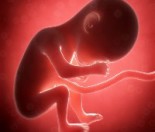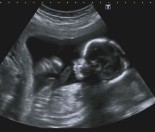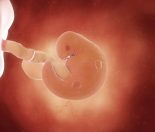This article examines fetal movements in pregnancy. Baby’s movements or kicks are a reflection of fetal health and well being in the womb.
What are fetal movements?
Fetal movements usually refer to the kicks that baby makes in the womb that are felt by the mother. Babies start moving very early in the pregnancy, but the baby is so tiny at this time that the mother will be unable to feel these movements. Eight weeks after your last menstrual period (when the baby is ‘6 weeks old’) the baby’s limbs will be forming, but the baby only measures 2cm in length. By 12 weeks the baby is fully formed, but still only 5cm long, so although baby will be moving you will be unable to feel it through the wall of your uterus, or womb.
Between 12-20 weeks the baby or fetus will be growing rapidly and will be about 18cm long by 20 weeks of pregnancy. It is usually around 16-20 weeks that mums first feel the flutter of the baby for the first time – this is known as ‘quickening’. Once you have felt your baby move you will tune into this feeling, which gets stronger and stronger as baby grows and becomes regular and frequent.
What is the significance of fetal movements in pregnancy?
By 20-22 weeks most mums are noticing their baby move most days. Occasionally it may be later than this – when women are overweight they may be later to feel the baby move due to cushioning of fatty tissue around the womb. Also if the placenta is located at the front of the womb this will mask some of the movement too.
Your midwife or doctor will ask about the baby’s movements at your regular check ups in pregnancy. As pregnancy progresses this becomes more and more important. By 28 weeks mothers are able to count definite, separate movements which indicate the well being and nourishment of their baby. Each ‘kick’ refers to a separate movement or series of movements. Therefore 10 kicks a day refers to 10 separate times in the day when you felt your baby move.
Some mothers feel only a few movements each day, some feel what seems like hundreds! A minimum of 10 movements a day is considered normal.
To understand fetal movements imagine a well toddler, running around and then taking regular rests in between – normal toddler behaviour. However, if that toddler were to lie still on the sofa for a long time when they did not usually nap, you would be suspicious and wonder if they were poorly….
If your baby is ‘still’ at a time that they normally kick then there may be cause for concern.
If your baby has reduced movements at any stage of your pregnancy – contact your LMC immediately.
| Find the Right Pregnancy & Birth Book for You!
Click here for the Most Popular International BestSellers |
||||
 |
 |
 |
||
The baby in the womb
Babies in the womb receive their oxygen and nutrients via the umbilical cord. This travels from mum, through the placenta to the baby, where it enters at the umbilicus (tummy button) and passes into the main circulation of the developing baby.
Likewise the baby’s waste products are removed from the baby through the vessels of the umbilical cord to the placenta, where they are diffused across to mum’s circulation for her to excrete or get rid of them.
This system relies upon:
- A good supply of oxygen and nutrients to the placenta
- Which in turn relies upon mother having healthy lungs, heart and blood vessels and being in an environment which is clean and well oxygenated
- The placenta being healthy and functioning
- The blood vessels in the umbilical cord being healthy to allow a good blood flow through them.
- The baby having a normal heart and blood vessels.
If any of these factors are reduced or missing then there will be a reduced oxygen and nutrient supply to the baby, which may lead to fetal distress.
Fetal distress in pregnancy would usually be picked up through reduced fetal movements or kicks.
What would happen if I had reduced fetal movements? 
If the baby has reduced movements and you report this to your LMC, your midwife or doctor will usually monitor the baby’s heart rate continuously for 20-30 minutes by cardiotocograph, or CTG which are available at hospitals and some birth centres. These machines have two pads which are placed over your abdomen that pick up baby’s heart beat and detect contractions if you are having them.
If the CTG recording shows signs of distress, such as an increase or decrease outside of the normal range of 110 -160 
If a reduced oxygen supply to your baby went undetected, this could lead to permanent damage to the vital organs of the body, such as the brain or kidneys. Ultimately your baby needs oxygen and glucose to survive and after a period of time your baby would run out of reserves and die. This is an extremely rare, but tragic event.
Please note that it is not normal for your baby to slow down the number of kicks towards the end of pregnancy – the movements change due to lack of space, but should never slow down.
Tips – What can I do to help my baby?
- Eat well in pregnancy to ensure good nutrition for your baby to lay down reserves for labour.
- Exercise gently throughout your pregnancy, to keep your own body healthy.
- Rest often, especially from 30 weeks. Ask friends and whanau to look after your toddlers for an hour or two so you can put your feet up!
- Ensure you drink plenty in the hot weather.
- Do not lie on your back in late pregnancy or labour – your womb and baby will squash the major blood vessels in your abdomen, reducing baby’s blood supply and making you feel faint.
Please remember that the vast majority of babies are robust and healthy and withstand pregnancy and labour amazingly well!
Most importantly, keep an eye on your baby’s movements every day!
Useful articles
For more information on the Implications of Fetal Distress in labour, visit our article in the Birth section.
Our registered dietitian has some great advice for Nutrition in Pregnancy. Click here to read about the important nutrients in pregnancy.










that would be very helpful.. thanks